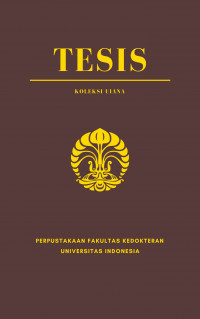Text
Volume Aliran Feeding Arteri Brachialis Pasca Operasi Fistula Arterivenosa Brachiocephalica Sebagai Prediktor Maturasi Fistula Arterivenosa Pada Pasien Penyakit Ginjal Tahap Akhir Dengan Diabetes Melitus Tipe 2 = Post Brachiocephalica Arteriovenous Fistula Feeding Brachial Artery Flow Volume as Maturation Predictor of Arteriovenous Fistula in End Staged Renal Diseases with Type 2 Diabetes Mellitus.
Latar Belakang: Walaupun transplantasi ginjal merupakan pilihan tatalaksana terbaik bagi penyakit ginjal tahap akhir, hingga saat ini hemodialisis masih merupakan modalitas terapi pengganti ginjal yang paling banyak dipilih, baik di negera maju maupun negera berkembang. Akses vaskular baku emas untuk hemodialisa adalah dengan fistula arteriovenosa. Namun, untuk dapat berfungsi sebagai akses hemodialisa fistula arteriovenosa membutuhkan waktu untuk mencapai maturasi. Tujuan: Untuk menganalisa hubungan volume aliran feeding arteri pada mingguminggu awal pasca operasi fistula arteriovenosa dan potensi volume aliran feeding arteri di minggu-minggu awal pasca operasi fistula arteriovenosa untuk dijadikan sebagai prediktor maturasi fistula arteriovenosa pada populasi pasien penyakit ginjal tahap akhir dengan diabetes melitus tipe 2. Metode: Desain yang digunakan adalah desain kohort retrospektif menggunakan data sekunder dari penelitian sebelumnya. . Data sekunder yang digunakan merupakan data dari pasien penyakit ginjal tahap akhir dengan komorbid diabetes melitus tipe 2 yang menjalani operasi konstruksi fistula arteriovenosa brachiocephalica. Hasil: Dari total 67 pasien yang memenuhi kriteria inklusi dan eksklusi, terdapat 47 (70,1%) pasien yang mengalami maturase dan sisanya tidak mengalami maturasi. Pada minggu pertama pasca operasi fistula arteriovenosa, kelompokt matur memiliki volume flow arteri feeding yang signifikan lebih tinggi daripada kelompok yang tidak matur (978.99 ±351.5 vs 555.42±215.9, p= < 0.001). Sedangkan nilai prediksi dari volume flow arteri feeding untuk maturasi sebesar 84,7% (IK95%: 75,2%-94,2%) untuk minggu pertama. Simpulan: Kelompok dengan fistula arteriovenosa matur memiliki rerata flow feeding artery yang lebih tinggi secara signifikan. Nilai ambang terbaik volume flow feeding artery didapatkan padaminggu 1 untuk memprediksi maturasi fistula arteriovenosa. Nilai ambang dengan sensitivitas terbaik di mana tidak ada fistula arteriovenosa yang matur dengan volume flow di bawa nilai tersebut adalah 343,67 mL/min (sensitivitas 100% dan spesifisitas 15%)
Kata kunci: Maturasi, Fistula arteriovenosa, Volume flow arteri feeding , Hemodialisa
Background: Although kidney transplantation is the treatment of choice for endstage renal disease, hemodialysis is still the most preferred modality for renal replacement therapy, both in developed and developing countries. The gold standard vascular access for hemodialysis is with arteriovenous fistulas. However, to be able to function for hemodialysis arteriovenous fistula takes time to reach maturation. Objective: To analyze the relationship of volume flow feeding artery in the early weeks after surgery of arteriovenous fistulas and the potential for of volume flow feeding artery in the early weeks after surgery for arteriovenous fistulas to be used as predictors of maturation of arteriovenous fistulas in a population of patients with end-stage renal disease with type 2 diabetes mellitus. . Method: The design used is a retrospective cohort design using secondary data from previous studies. . Secondary data used were data from patients with endstage renal disease with comorbid diabetes mellitus type 2 who underwent construction surgery for brachiocephalic arteriovenous fistula. Results: Of the total 67 patients who met the inclusion and exclusion criteria, there were 47 (70.1%) patients who had maturation and the rest did not. In the first week postoperative arteriovenous fistula, the mature group had a significantly higher volume of feeding artery flow than the immature group (978.99 ± 351.5 vs 555.42 ± 215.9, p = < 0.001). Meanwhile, the predictive value of the feeding artery flow volume for maturation was 84.7% (95% CI: 75.2% -94.2%) for the first week. Conclusion: The mature group of arteriovenous fistulas had a significantly higher rate of artery feeding flow. The best threshold value for artery flow feeding volume was obtained at week 1 to predict maturation of arteriovenous fistulas. The threshold value with the best sensitivity where there are no mature arteriovenous fistulas with a volume flow below this value is 343.67 mL / min (sensitivity 100% and specificity 15%)
Keywords: Maturation, Arteriovenous fistula, Volume flow arteri feeding, Hemodiaysis.
- Judul Seri
-
-
- Tahun Terbit
-
2020
- Pengarang
-
Purnama Satria Bakti - Nama Orang
Dedy Pratama - Nama Orang
Aria Kekalih - Nama Orang - No. Panggil
-
T20389fk
- Penerbit
- Jakarta : PPDS Sp-2 Ilmu Bedah., 2020
- Deskripsi Fisik
-
xviii, 48 hal; ill; 21 x 30 cm
- Bahasa
-
Indonesia
- ISBN/ISSN
-
-
- Klasifikasi
-
NONE
- Edisi
-
-
- Subjek
- Info Detail Spesifik
-
Tanpa Hardcopy
| T20389fk | T20389fk | Perpustakaan FKUI | Tersedia |


Masuk ke area anggota untuk memberikan review tentang koleksi